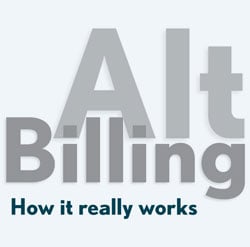Facing the Alternative: How Does a Flat Fee System Really Work?

Rebecca Weinstein Bacon: “Alternative fee structures require balancing the workload with the number of lawyers needed.” Photo by Saverio Truglia
While every law firm is culturally unique, often the same fears and concerns—namely diminished profit margins and budget difficulties—plague outside counsel when it comes to changing billing practices. For many, creative fee schemes seem to create more nightmares than profits. But a few outside firms and their business clients have found a way to make it all work. The secret is in trust, sharing and statistics.
In 2004 global industrial conglomerate Tyco International Ltd. issued an open request for proposals for law firms to craft new and different models for its litigation work. Eager to achieve greater predictability of cost and legal spending, the company was also willing, for the first time, to place its entire product liability docket (the company’s largest program) with a single firm, what it calls the convergence model. More than 20 firms responded, some of which had been longtime service providers to the company.
“We went to the convergence model because it [represents] best practices in our view,” says Dennis P. Lynch, vice president and chief litigation counsel at Tyco. “At the same time we were in the process in 2003-2004 of building the law department, so we had limited resources to deal with litigation, among other things. So it was also a practical thing for us to do; the combination of cost savings and more efficiency fit the needs of the corporation.”
“Litigation is very difficult to budget because you don’t know how litigation is going to turn out,” Lynch says. “A case without large exposure could cost you as much as a case with large exposure to risk. There is a lot of unpredictability; you’re really giving as much certainty as you can to a very unpredictable effort.”
Although litigation boutique Shook Hardy & Bacon was familiar with nontraditional fee arrangements—the Kansas City, Mo.-based firm had created an alternative fee program for Ford Motor Co. in the mid-’90s—partner Paul Williams had never represented the security-systems giant nor handled an entire national docket.
Today Shook Hardy is Tyco’s sole legal services provider for product liability, automobile and general liability matters. When local counsel is needed, the law firm determines who to bring on board and manages the entire legal team for each case rather than the company’s legal department.
“I think it has worked well because we’ve truly partnered with them,” Lynch says. “They’ve gotten to know well the players here, the business, products and obviously the law department. And we do work as partners—and that trust, which goes both ways, goes a long way to building a relationship as good as this one is.”
And according to Shook Hardy, more than 30 percent of its revenue comes from alternative fee arrangements now, and that number continues to grow.
The key to Shook Hardy’s successful pitch? Increased collaboration and trust between the firm and its potential client from the initial fee pitch and negotiation process through the close of a matter.
“From an industry standpoint, a lot of outside firms and in-house counsel are exploring alternative fees,” says Williams. “But there is trepidation about how to make it work or take those steps to see how it would apply. A lot of firms are talking, but they don’t know how to do it.”
IT TAKES TRUST
The transformation to single or limited legal providers may not be a major trend, but as clients demand more value for their dollars spent, it is a step more large corporations are considering and more law firms must deal with. It is also a policy that demands faith and trust on both sides of the equation.
Clients need to trust enough to give more information to their outside counsel, and law firms need to invest more time and effort in case management and tracking, building on that trust.
Rebecca Weinstein Bacon, a Chicago-based partner at Bartlit Beck Herman Palenchar & Scott, says determining the work that is necessary and the lawyers needed to do that work is both required and liberating.
“With an alternative fee structure, you constantly assess what work is necessary to win the case,” she says. “There’s no incentive to perform work for work’s sake.

Click here (PDF) for a step-by-step look at the litigation process, comparing a traditional billing structure to an alternative billing structure.
“If you determine it is necessary to have a meeting with three partners, there’s nothing stopping you from doing that. Whereas traditionally, if you have three partners in a meeting you might wonder, ‘What will the client think? Will this be too many people? Will I have to write off hours?’ ”
Incentives that incorporate rewards for charging less than proposed budgets and sharing unforeseen costs also foster good will between clients and lawyers.
At the outset of the RFP process, Tyco provided law firms with historical information as to how cases had been handled. Having had relationships with more than 160 firms, the forecast for savings from more efficient processes and fewer outside counsel was apparent. The more difficult measurement was the exact forecast for legal spending under the direction of a single firm.
While Williams admits the learning curve for Shook Hardy was steep, the firm has made strides to handle case management information and more accurately pinpoint the sweet spot of increased value to the client and profit for the firm.
The model includes a heavy focus on effective staffing and case-management techniques that meet client objectives such as budget and shareholder interests, as well as successful legal representation.
Williams says his cases are managed better than before, and they are leaner and more efficient. And Shook Hardy has been able to increase its profit while decreasing client spending and caseloads throughout its seven-year relationship with Tyco.
“It doesn’t make sense to keep the same fee if it takes you less time,” Williams explains. “We all want raises, but … you will wind up working yourself out of a job. There will come a balance point, but we aren’t there yet. We’re still able to wring efficiencies out of the program.”
Under a collar arrangement to the program’s budget and fees, Shook Hardy retains a portion of the projected fees as a bonus when it comes in under budget, but it is also responsible for a portion of overages before a shared-cost safety valve kicks in.
“We have the opportunity to beat the budget and earn a bonus,” Williams says, “but if we beat the budget big time, we’re able to also put money back in the client’s pocket and make them all the more happy. Our skin in the game comes on the topside because the firm has to absorb a certain over-the-top amount before relief [from Tyco] is provided.” Patrick Lamb, founder of Chicago’s Valorem Law Group, which offers only alternative billing, says getting that “skin” in can determine a firm’s success.
“More sophisticated clients won’t accept alternative arrangements that are simply an hourly structure with a cap or floor,” he says, “because those enable the same inefficiencies as straight hourly billing. Firms that restructure themselves to have skin in the game when it comes to fees stand to have the most successful and profitable client relationships.”

Paul Williams: “A lot of outside firms and in-house counsel are exploring alternative fees,… but they don’t know how to do it.” Photo by Nick Vedros
THE CASE OF 500 CASES
When Tyco integrated its nationwide docket of matters to a single firm, Shook Hardy’s lawyers inherited more than 500 cases. Over time, “we’ve been able to get a handle on the caseload,” Williams says, as well as provide uniform representation on cases across the country.
To boost effectiveness, the firm routinely captures case updates, such as summaries from depositions and court hearings across the country, in a centralized knowledge management system that includes shared resources and training procedures to educate lawyers who join the Tyco team. Shook Hardy also logs and analyzes real-time financial and billing data to allow the firm—and Tyco—to track detailed expenses such as the cost of specialty expertise.
“We can look at the docket and forecast expenditures with confidence for the upcoming year,” Williams says.
Today, Tyco has slightly more than 200 cases on an annual basis. New cases filed against the company have dropped 60 percent since Shook Hardy’s involvement.
Although many lawyers say they aren’t able to offer alternative arrangements without a predictable body of cases, Williams suggests otherwise.
“One of the myths out there is that a firm needs repetitive litigation to make these types of arrangements work,” Williams says. “We make this program work for Tyco with hundreds of different cases. We’re able to give control to the client of where ‘spend’ is going and provide accurate predictions even though many cases are one of a kind.”
Even better, he says his firm has been able to modify its case-management approach in ways that still reduce a client’s legal spending and increase the firm’s profit.
“You don’t approach cases with the same plodding mentality,” Williams says. Traditionally, if a firm needed additional ammunition on a case, it would simply hire more people and pass the costs to the client. Under alternative fee structures where the outside firm is responsible for controlling costs of local counsel and experts, staffing is a more judicious process.
Shook Hardy has brought on more laterals with eight- to-10 years’ experience “who aren’t on traditional partner paths,” Williams says. “This gives the firm greater economic flexibility and clients the experience they desire. The attorneys with greater expertise and higher billing rates can handle the issues they need to, but the bulk of the work is done by senior attorneys who are less costly to the firm so we don’t price ourselves out of the billing model.”
Firms using alternative billing also need to look at strategic objectives, target the different possible conclusions and set specific goals to reach those objectives, which for Williams is often to get his client out of a case.
“Rather than an old-school approach of starting the process with some motions and discovery—or the A- to-Z method to do everything that you can possibly do—setting specific business goals for a case allows for quicker turnaround and resolutions,” Williams says.
Cycle time of a case is paramount, he says. Strategies and exit paths are usually identified and charted from the date the case is accepted, and they are projected out for 120 days.
“Traditionally, the longer a lawyer keeps a case, the more expensive it will be,” Williams says. “But if an exit strategy is implemented as soon as possible, the client will save money. If you can win a case on a motion, do it within six months—not after two years of discovery.”
Inheriting a single docket for a company also allows for easier integration of business and legal objectives. From a cost perspective, concentrating a greater portion of legal spending with fewer firms gives clients leverage to control costs and eases trepidation among outside firms while they test successful billing arrangements.
A large amount of work and a set length to the contract are also important alternative billing elements.
“Taking on an entire portfolio allows firms to diversify risk,” explains Chicago-based Foley & Lardner partner Patrick Daugherty, allowing profitable cases to compensate for unprofitable ones and giving the outside firm a better grasp of a company’s big legal picture and goals. Arrangements of shorter durations are also better because they minimize the risk of getting stuck in unprofitable engagements.
COMPLEXITY HINDERS ANALYSIS
Even as new billing arrangements are heralded as the antidote to the vilified billable hour by general counsel desperate for predictable legal costs, many law firms are scrambling to propose alternative measures like flat- or fixed-fee rates that don’t promote the “skin in the game”—the risk-sharing mentality that clients seek.
These issues have fueled silence or finger-pointing between clients and firms to explain why they don’t opt for billable-hour alternatives.
“Alternative fees are very sophisticated,” says Hal M. Stewart, chief operating officer at New York City-based Chadbourne & Parke, citing deadline rate changes, discounts and incentives for winning among the considerations often on the table. “Depending on the nature of the practice area, it becomes very complex.”
Stewart recalls a conversation in which he asked a partner at a high-profile firm about alternative billing methods. “I’ve been doing them for years,” the New York lawyer quipped, according to Stewart, “but I’m not sure I’m making any money.”
Many firms don’t have the proper infrastructure to track the profitability of alternative billing, Stewart suggests, because they typically haven’t tracked profits for individual matters under the billable hour.
“Most traditional firms track revenue production and productivity on an hourly basis,” Stewart says, “but unless there is a fee cap or a client refuses to pay a bill, there isn’t usually danger of losing money or profit. There’s not much that needs to be watched aside from the client’s happiness.”
Standard billing and tracking models can’t provide the analysis necessary for lawyers to effectively and accurately predict how a future matter should be priced, he says. Firms need to develop the infrastructure and fee-analysis programs to effectively implement alter native pricing models from cradle to grave, including initial proposals, case management, staffing standards, revenue analysis and post-engagement reviews.
“Without those tools in place, it’s purely guesswork,” Stewart says of negotiating alternative fees. “It isn’t that firms aren’t organized well, but firms need to reorganize … to be more efficient in regard to alternative fees. Firms need to develop models and dig deep into metrics and financials.”
At Foley & Lardner, Daugherty says, the Am Law 100 firm invested more than $1 million to build a Web-based management tool that allows clients and counsel to track expenses in real time.
“We asked our IT lawyers to bring to bear, on our own systems for the benefit of all our clients, what they had learned in their work with and for their own clients,” Daugherty says. The system graphs cumulative budgets for individual matters, charts the number of partners and associates staffed, and documents the percentage of work completed as compared to the percentage of the budgeted expense. This gives clients and lawyers the ability to communicate and react quickly if adjustments need to be made. More than 1,200 matters are covered by Foley’s Web-based tool at this point.
Increased sophistication in tracking legal expenses should extend to expert witness costs. The attention a firm pays to managing these types of expenditures over the life of a case is paramount to successful alternative billing arrangements, adds Buckmaster de Wolf, litigation and legal policy senior counsel for General Electric Co.
“The firms are the closest to the experts and can manage those relationships better than we can,” de Wolf said at an ABA Journal roundtable discussion on alternative and value-driven fee programs. “They need to manage the experts like we manage the firms.”
And though clients can monitor who is working on their matter—a hot-button issue for law departments that refuse to pay for the work of inexperienced associates —Daugherty and de Wolf agree that alternative arrangements reduce client henpecking on staffing issues.
DOWN TO SIZE
Although usually driven by the client, alternative fee arrangements have other advantages. They’ve become the weapon of choice for midsize firms looking to lure sophisticated Fortune 100 clients from their BigLaw counterparts.
“It’s a major focus,” says Kip Reader, Cleveland-based managing partner of Ulmer & Berne. Although the regional firm had embraced capped and fixed-fee arrangements in the past, the recession has made alternative fees “a necessary tool in the competitive marketplace.”
It’s not uncommon for firms to combine various billing methods into a single agreement, Reader says, but firms need to be willing to take risks and allow for transition periods when making the switch: “There’s an education and experiment process involved in alternative fee arrangements.”
Meanwhile, the increased flow of information and trust between law firms and law departments can benefit the GC in-house, beyond the law department. “Firms are more flexible,” de Wolf says, “and the relationships between GCs and finance departments are enhanced.”
When a firm’s relationship with its client also boosts the GC’s relationship within the company’s C-suite, it’s easier to promote innovative fee schemes, notes Shook Hardy’s Williams.
Still, despite the lessened risk, increased control and more shared information, alternative fee arrangements aren’t always an easy sell to corporate clients. Williams worked with another client that wanted to go the alternative fee route, but the company’s in-house risk department vetoed nontraditional fee arrangements.
“Even though it makes practical economic sense,” Williams says, “I think general counsel and some C-suite executives have a natural inclination to think about [alternative billing], ponder it and take time to assess rather than jump right in like Tyco.
“So my view is it will continue to be a part of the legal landscape and will ultimately, in time, grow as people become comfortable with the tools to be successful for both sides,” Williams says, “but I don’t think hourly fees will go away, and there will be some clients that prefer a simple boilerplate approach rather than having to think outside the box.
“As C-suites roll over and you get more innovative thinkers,” he says, “you may see more willingness to be more creative and innovative in how they go about dealing with fee arrangements.”



